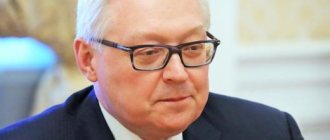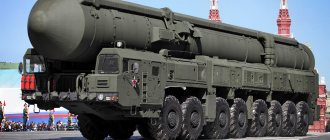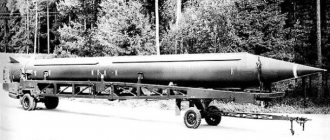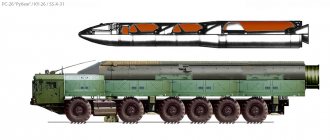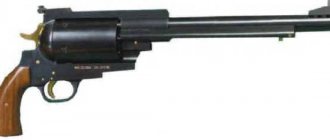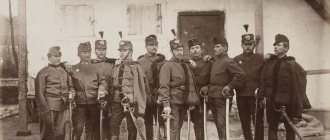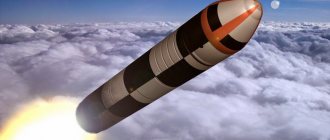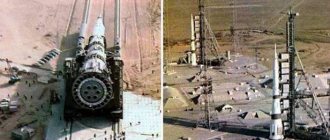Surprisingly, the group of R-7 launch vehicles had a fairly long life. The designers did not even imagine that the R-7 rocket (the world's first intercontinental missile) would be able to survive not only foreign analogues, but also later domestic developments, for example, Proton.
The missile's combat career was unremarkable and short, but the enormous contribution of the R-7 to space exploration cannot be overestimated. The rocket was able to usher in an era in which the space race became a matter of national importance, and continues to be used in our time when private enterprises take over the initiative.
History of creation
The first Soviet ballistic missile R-1 took off in 1948. Its flight range did not exceed 300 km. The R-2, put into service in 1951, could already reach targets at ranges of up to 600 km. This was still not enough for a nuclear charge to penetrate deep into enemy territory, but work on the creation of long-range missiles had already begun.
And in the spring of 1954, a resolution of the Council of Ministers was issued, ordering the Korolev design bureau to create the R-7 intercontinental missile. It is significant that the “seven” initially had a dual purpose - the resolution already stipulated the possibility of launching spacecraft with its help.
In 1955, construction of an ICBM testing site began in Kazakhstan - it would later become the famous Baikonur Cosmodrome.
In 1957, the first R-7s (which then received the index 8K17) began to arrive from Moscow. The first launch of the “product” turned out to be an emergency. In general, out of the first five launches, only one was partially successful, which allowed TASS to announce the creation of the first intercontinental missile (without mentioning that the warhead collapsed in the atmosphere).
But the first launch of a “civilian” carrier was truly triumphant. In October 1957, with the help of the R-7, the first artificial satellite in history went into orbit. In 1958, the second phase of testing began. The warhead was changed in order to avoid its destruction upon re-entry into the atmosphere.
Emergency launches continued, but destruction of the warhead was finally avoided. The design was finally finalized after the third phase of testing, which took place during 1959. And in 1960 it was put into service. For combat launches, a cosmodrome was built in Plesetsk.
R-7 rocket design
R-7 was developed by OKB-1 and designed according to the “package” scheme.
The first stage of the rocket consists of four side blocks, each 19 m long and with a maximum diameter of 3 m. They are located symmetrically around the second stage and are connected to it by upper and lower power connections.
The design of the blocks is the same. The block consists of a support cone, fuel tanks, a power ring, a tail section and a propulsion system. All blocks had an RD-107 liquid-propellant rocket engine with a pump supply of fuel components. The engine was made in an open design and consisted of six combustion chambers. Moreover, two of them were used as helmsmen. The liquid-propellant rocket engine developed a thrust of 78 tons at the ground.
The second stage of the R-7 rocket consisted of an instrument compartment, tanks for oxidizer and fuel, a power ring, a tail section, a propulsion engine and four steering units. It was equipped with a liquid propellant rocket engine RD-108, similar in design to the RD-107, but had 4 steering chambers. It developed a thrust of 71 tons at the ground, turned on simultaneously with the first stage engines at the start and worked, accordingly, longer than the first stage rocket engine.
All engines of both stages were fired at the launch for the reason that at that time the rocket developers did not have confidence in the possibility of reliable ignition of the second stage engines at high altitude. American rocket scientists faced a similar problem when creating the Atlas ICBM at the same time.
All engines used two-component fuel: oxidizer - liquid oxygen, fuel - T-1 kerosene. To drive turbopump units of rocket engines, hot gas formed in a gas generator during the catalytic decomposition of hydrogen peroxide was used, and compressed nitrogen was used to pressurize the tanks. To achieve the required flight range, an automatic system for regulating engine operating modes and a synchronous tank emptying system (SEB) were installed, which made it possible to reduce the guaranteed fuel supply.
The design and layout of the R-7 ensured that all engines were started at start (including the remote control of the central unit) using special ignition devices installed in each of the 32 combustion chambers.
Sustaining liquid-propellant rockets had high energy and mass characteristics for their time, as well as high reliability.
The R-7 had a combined control system. The autonomous subsystem provided angular stabilization and stabilization of the center of mass in the active part of the trajectory. The radio subsystem corrected the lateral movement of the center of mass at the end of the active part of the trajectory and issued a command to turn off the engines. The executive bodies of the control system were the rotating chambers of the steering motors and air rudders.
For radio correction, two control points (main and mirror) were built, located 276 km from the starting position and 552 km from each other. Measurement of R-7 motion parameters and transmission of missile control commands was carried out by a pulsed multi-channel communication line. She worked in the 3-centimeter wavelength range with coded signals. A special calculating and solving device, located at the main point, made it possible to control the flight range; it gave the command to turn off the second stage engine when a given speed and coordinates were reached.
After successful launches of the 8K71 as a ballistic missile, it was used in 1957 to launch the world's first artificial Earth satellites. Since then, launch vehicles of the R-7 family have been actively used to launch spacecraft for various purposes, and since 1961, these launch vehicles have been widely used in manned astronautics.
Who created the first “space” rocket of the Soviet Union?
“Seven”, R-7, BRDD are different names for the same “ product” No. 8K71 .” Long-range ballistic missiles were used under this code in the technical documentation and closed resolutions of the Central Committee and the Council of Ministers. And by the way, not just any kind, but the world’s first intercontinental ballistic missile with a detachable warhead weighing 3 tons and a flight range of 8 thousand km.
Even if Sergei Pavlovich Korolev had created only one “seven” (the R-7 rocket), his contribution to the development of domestic cosmonautics would have been enormous.
However, even earlier the designation “Tema-1” and the T-1 . The abstracts of the report on the results of a study of the prospects for the development of weapons designed to deprive America of invulnerability, which Sergei Pavlovich Korolev spoke at the technical council of NII-88, are dated December 27, 1951. At the same time, the scientific council of the institute approved the proposals of the chief designer.
But the “package” layout system incorporated into the design of the R-7 rocket first appeared in the works of Konstantin Eduardovich Tsiolkovsky. Later, M.K. Tikhonravov substantiated the rationality of the “scheme for a package of blocks of various sizes.” However, anticipating the natural question: “Who is the true creator of the Seven?”, I will say this:
a structurally homogeneous package was calculated according to the instructions of S.P. Korolev at the M.V. Keldysh Institute, the design department of the OKB was headed by K.D. Bushuev, engineers G.Yu. Maksimov, S.S. Okhapkin, chief designer Sergei Sergeevich Kryukov, Korolev’s first deputy V.P. Mishin contributed a lot... Engines - V.P. Glushko, on-board systems - N.A. Pilyugin, V.I. Kuznetsov, M.S. Ryazansky... Okhapkin was also a deputy in the project, he was even called “the chief designer under the chief designer.”
In short, it is difficult to list all those involved. Rather, it is difficult to single out those who contributed almost nothing to the project - too many outstanding minds of their time worked on the project of this rocket. And yet the “seven” is rightly called the royal one.
After all, Sergei Pavlovich, as the chief designer, had to force people to listen to himself, think like him, influence events, and gather personalities around him. Just as the music created by an orchestra is composed of numerous and varied, but interconnected sounds, so is the design community of engineers. Each of them develops his own consciousness, dealing not only with what is in his own thoughts and memory, but also with new ideas that he receives from others.
In 1953, the design of the future rocket was chosen, and preliminary design began.
The first fall and subsequent ups
The first unsuccessful test of the R-7 took place in the spring of 1957. The ICBM gained altitude, but after 1.5 minutes began to fall rapidly. After a few more tests, the designers managed to eliminate the defects. In the summer of the same year, the R-7 took off again and covered more than 6,000 km - so the USSR became the owner of the world's first ICBM.
And this flight of the “seven” did not go smoothly; part of the rocket was destroyed due to thermodynamic overloads. In 1958, more than 90 changes were made to the R-7 structure, the improved design no longer had technical problems. Now the updated R-7 model made it possible to reduce the preparation time for launch, improve accuracy and increase the flight range to 12,000 km.
Links[edit]
- Wade, Mark. "R-7". Encyclopedia Astronautica
. Retrieved July 4, 2011. - "R-7 rocket". RSC Energia named after. S.P. Queen.
- Bora, Champak Jyoti. Missile systems. Lulu.com. paragraph 11. ISBN 978-1-329-59323-7. [ self-published source
] - ^ abc "Boris Chertok: Rockets and People, p. 290" (PDF). Archived from the original (PDF) on May 11, 2008.
- ↑
Huntress, Wesley;
Marov, Mikhail (2011). Soviet Robots in the Solar System: Technology and Mission Discovery
. Chichester, UK: Praxis Publishing. pp. 63–65. ISBN 978-1-4419-7897-4. - "This Week in EUCOM History: 6–12 February 1959". EUCOM. February 6, 2012 Archived from the original on September 21, 2012. Retrieved February 8, 2012.
- "R-7, "Seven"". Archived from the original on July 8, 2011. Retrieved September 4, 2008.
- The Kremlin's Nuclear Sword
, Stephen J. Zaloga, Smithsonian Institution Press, Washington and London, 2002.
Exploitation
The R-7 was removed from service just a few years later, in 1968. To launch the S7s, a stationary launch complex with extensive infrastructure was required.
The missile, ready for launch, could not remain in combat readiness for a long time, and the achieved accuracy was insufficient.
But all this concerned only military specifics. And the “research” career of the “seven” continued. Back in 1958, work began on a three-stage modification “Luna”, which launched interplanetary stations into orbit. Its modernized version, Vostok, launched not only satellites into space, but also the world’s first manned spacecraft.
Four-stage Molniya rockets, used until 2010, delivered landers to the Moon for the first time. Their three-stage Voskhod variant made it possible to launch ships with a crew of several people.
But the most advanced and widespread modification of the R-7 was the Soyuz rocket, which became a further development of the Voskhod. They are still in use, moreover, the latest version of Soyuz-2 is considered to be quite modern in terms of characteristics. By the way, a big role is played by the refinement of the design and streamlined production.
Characteristics
For comparison with the strategic R-7, let’s take the American Atlas ballistic missile created at the same time.
| R-7A | SM-65EAtlas | |
| Number of steps | 2 | 1,5 |
| Launch weight, tons | 276 | 118 |
| Maximum range, km | 12000 | 10200 |
| Warhead power, megatons | 2,9 | 4,4 |
| Time to prepare for launch, minutes | 80 | 10 |
The “one and a half stage” design of the Atlas ICBM meant that the jettisonable starting engines were not considered a full-fledged first stage. We can conclude that the Atlases were the best combat complex - they had less mass, were brought into combat readiness faster, and a higher-power charge was developed for them.
But their life turned out to be even shorter than that of the ballistic R-7 - already in 1964, after the appearance of the latest modification, the Atlases began to be replaced by the more advanced Minutemen. But the American rocket was simply not suitable for launching spaceships.
Modifications
The R-7 itself and its modification R-7A were in service with the Strategic Missile Forces for a short time and in small quantities. However, the 8K71 developed by Sergei Korolev turned out to be a reliable and powerful rocket, capable of multi-stage modernization, which allowed it to become the most popular type of launch vehicle in the 20th century. In total, there are more than 20 modifications of the R-7, the main of which are:
- R-7A (8K74) - modification with an increased firing range, a new warhead and radio control system;
- “Sputnik” (8K71PS) - a variant of the R-7, which carried a payload (an artificial Earth satellite) instead of combat equipment;
- Sputnik-3 (8A91) - with an increased payload, without a radio control system;
- “Polet” (11A59) is a lightweight two-stage launch vehicle for launching maneuvering satellites into orbit;
- "Luna" (Vostok-L, 8K72) - equipped with a third stage, designed for launching spacecraft to the Moon;
- "Vostok" ("Vostok-K", "Vostok-2", "Vostok-2M", 8K72K, 8A92, 8A92M) - with more powerful third-stage engines, it was this launch vehicle that first launched a manned spacecraft into space with a man on board;
- "Molniya" and "Molniya-M" (8K78 and 8K78M) - a four-stage light-class launch vehicle;
- "Voskhod" (11K57) - with a new third stage;
- "Soyuz" (11A511) and "Soyuz-2" (14A14) - a deep modernization of the R-7, one of the largest families of Soviet and Russian launch vehicles, widely used in Soviet cosmonautics until the 2010s.
Description[edit]
The R-7 was 34 m (112 ft) long, 10.3 m (34 ft) in diameter, and weighed 280 metric tons (280 long tons; 310 short tons); it had two stages, powered by rocket engines using liquid oxygen (LOX) and kerosene and capable of delivering its payload up to 8,800 km (5,500 mi), with an accuracy of about 5 km (3.1 mi). A single thermonuclear warhead had a nominal yield of 3 megatons of TNT. The initial launch was boosted by four mounted liquid rocket boosters making up the first stage, with an engine powering both the first and second stages. Each mounted booster included two vernier thrusters, and the main stage included four. [2] The guidance system was inertial with radio-controlled vernier engines.
